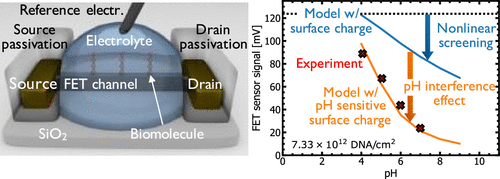Our official English website, www.x-mol.net, welcomes your
feedback! (Note: you will need to create a separate account there.)
The Significance of Nonlinear Screening and the pH Interference Mechanism in Field-Effect Transistor Molecular Sensors
ACS Sensors ( IF 8.2 ) Pub Date : 2021-01-26 , DOI: 10.1021/acssensors.0c02285 Sybren Santermans 1, 2 , Franz Schanovsky 3 , Mihir Gupta 1, 4 , Geert Hellings 1 , Marc Heyns 1, 2 , Willem Van Roy 1 , Koen Martens 1
ACS Sensors ( IF 8.2 ) Pub Date : 2021-01-26 , DOI: 10.1021/acssensors.0c02285 Sybren Santermans 1, 2 , Franz Schanovsky 3 , Mihir Gupta 1, 4 , Geert Hellings 1 , Marc Heyns 1, 2 , Willem Van Roy 1 , Koen Martens 1
Affiliation

|
Electrolyte screening is well known for its detrimental impact on the sensitivity of liquid-gated field-effect transistor (FET) molecular sensors and is mostly described by the linearized Debye–Hückel model. However, charged and pH-sensitive FET sensing surfaces can limit the FET molecular sensitivity beyond the Debye–Hückel screening formalism. Pre-existing surface charges can lead to the breakdown of Debye–Hückel screening and induce enhanced nonlinear Poisson–Boltzmann screening. Moreover, the charging of the pH-sensitive surface groups interferes with biomolecule sensing resulting in a pH interference mechanism. With analytical equations and TCAD simulations, we highlight that the Debye–Hückel approximation can underestimate screening and overestimate FET molecular sensitivity by more than an order of magnitude. Screening strengthens significantly beyond Debye–Hückel in the proximity of even moderately charged surfaces and biomolecule charge densities (≥1 × 1012 q/cm2). We experimentally show the strong impact of both nonlinear screening and the pH interference effect on charge-based biomolecular sensing using a model system based on the covalent binding of single-stranded DNA on silicon FET sensors. The DNA signal increases from 24 mV at pH 7 to 96 mV at pH 3 in 1.5 mM PBS for a DNA density of 7 × 1012 DNA/cm2. Our model quantitatively explains the signal’s pH dependence with roughly equal nonlinear screening and pH interference contributions. This work shows the importance of reducing the net charge and the pH sensitivity of the sensing surface to improve molecular sensing. Therefore, tailoring the gate dielectric and functional layer of FET sensors is a promising route to strong silicon FET molecular sensitivity boosts.
中文翻译:

场效应晶体管分子传感器中非线性筛选和pH干扰机制的意义
电解质筛选因其对液体门控场效应晶体管(FET)分子传感器灵敏度的不利影响而众所周知,并且主要由线性化的Debye-Hückel模型来描述。但是,带电且对pH敏感的FET感应表面可能会限制FET分子的灵敏度,超出Debye-Hückel筛选形式。预先存在的表面电荷会导致Debye–Hückel屏蔽的失效,并引起增强的非线性Poisson–Boltzmann屏蔽。此外,pH敏感表面基团的电荷会干扰生物分子的感应,从而导致pH干扰机制。通过分析方程式和TCAD模拟,我们强调了Debye-Hückel近似可以低估筛选,并高估FET分子灵敏度超过一个数量级。12 q / cm 2)。我们使用基于单链DNA在硅FET传感器上的共价结合的模型系统,实验性地显示了非线性筛选和pH干扰效应对基于电荷的生物分子传感的强大影响。DNA密度为7×10 12 DNA / cm 2时,在1.5 mM PBS中,DNA信号从pH 7的24 mV增加到pH 3的96 mV。。我们的模型通过大致相等的非线性筛选和pH干扰贡献定量地解释了信号的pH依赖性。这项工作表明了减少净电荷和降低传感表面的pH敏感性以改善分子传感的重要性。因此,定制FET传感器的栅极介电层和功能层是增强硅FET分子灵敏度的有前途的途径。
更新日期:2021-03-26
中文翻译:

场效应晶体管分子传感器中非线性筛选和pH干扰机制的意义
电解质筛选因其对液体门控场效应晶体管(FET)分子传感器灵敏度的不利影响而众所周知,并且主要由线性化的Debye-Hückel模型来描述。但是,带电且对pH敏感的FET感应表面可能会限制FET分子的灵敏度,超出Debye-Hückel筛选形式。预先存在的表面电荷会导致Debye–Hückel屏蔽的失效,并引起增强的非线性Poisson–Boltzmann屏蔽。此外,pH敏感表面基团的电荷会干扰生物分子的感应,从而导致pH干扰机制。通过分析方程式和TCAD模拟,我们强调了Debye-Hückel近似可以低估筛选,并高估FET分子灵敏度超过一个数量级。12 q / cm 2)。我们使用基于单链DNA在硅FET传感器上的共价结合的模型系统,实验性地显示了非线性筛选和pH干扰效应对基于电荷的生物分子传感的强大影响。DNA密度为7×10 12 DNA / cm 2时,在1.5 mM PBS中,DNA信号从pH 7的24 mV增加到pH 3的96 mV。。我们的模型通过大致相等的非线性筛选和pH干扰贡献定量地解释了信号的pH依赖性。这项工作表明了减少净电荷和降低传感表面的pH敏感性以改善分子传感的重要性。因此,定制FET传感器的栅极介电层和功能层是增强硅FET分子灵敏度的有前途的途径。











































 京公网安备 11010802027423号
京公网安备 11010802027423号